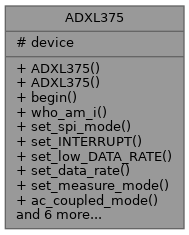 |
MRAS
Multi Rocket Avionics System
|
 |
MRAS
Multi Rocket Avionics System
|

Public Member Functions | |
| ADXL375 (TwoWire *pipe, uint32_t freq) | |
| ADXL375 (byte chipSelect, SPIClass &spi, uint32_t freq) | |
| void | begin () |
| byte | who_am_i () |
| uint8_t | set_spi_mode (bool enable) |
| uint8_t | set_INTERRUPT (int bit_num, bool set_pin, ADXL375_INTERRUPTS interrupt, bool enable) |
| uint8_t | set_low_DATA_RATE (ADXL375_Low_power_ODR rate) |
| uint8_t | set_data_rate (ADXL375_ODR rate) |
| uint8_t | set_measure_mode (bool enable) |
| uint8_t | ac_coupled_mode (bool enable) |
| uint8_t | set_fifo_mode (ADXL375_FIFO_MODES mode) |
| uint8_t | default_configuration () |
| float | self_test () |
| Vector< double, 3 > | get_accel () |
| protocol * | get_device () |
| uint8_t | reset () |
Protected Attributes | |
| protocol * | device |
| uint8_t ADXL375::reset | ( | ) |
Write to all registers their default values.
| float ADXL375::self_test | ( | ) |
Run the self test procedure as described in the datasheet page 29.
| uint8_t ADXL375::set_data_rate | ( | ADXL375_ODR | rate | ) |
Set the device bandwidth and output data rate. Default is 100Hz ADXL375_ODR.
The selected output data rate must be appropriate for the communication protocol and frequency selected.
Selecting an output data rate that is too high for the communication speed may result in samples being discarded
| rate | The new Output Data Rate to set |